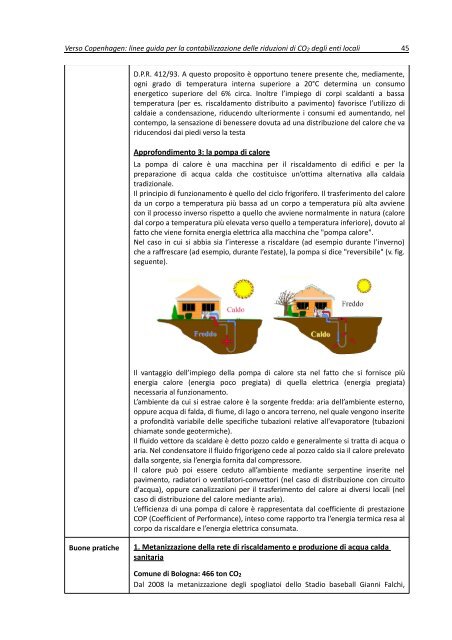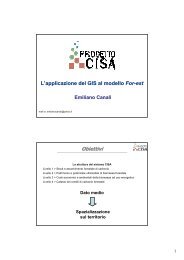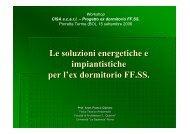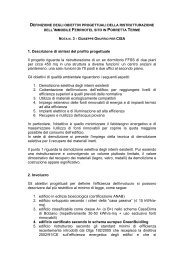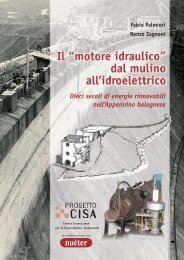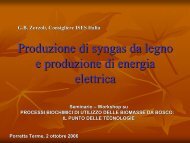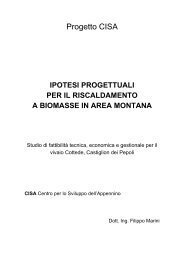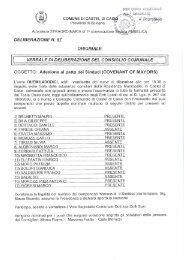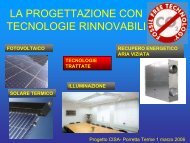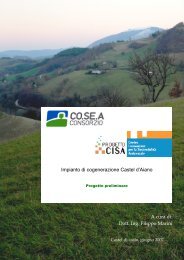Le linee guida per la contabilizzazione delle riduzione di CO2 degli ...
Le linee guida per la contabilizzazione delle riduzione di CO2 degli ...
Le linee guida per la contabilizzazione delle riduzione di CO2 degli ...
You also want an ePaper? Increase the reach of your titles
YUMPU automatically turns print PDFs into web optimized ePapers that Google loves.
Verso Copenhagen: <strong>linee</strong> <strong>guida</strong> <strong>per</strong> <strong>la</strong> <strong>contabilizzazione</strong> <strong>delle</strong> riduzioni <strong>di</strong> <strong>CO2</strong> <strong>degli</strong> enti locali 45<br />
D.P.R. 412/93. A questo proposito è opportuno tenere presente che, me<strong>di</strong>amente,<br />
ogni grado <strong>di</strong> tem<strong>per</strong>atura interna su<strong>per</strong>iore a 20°C determina un consumo<br />
energetico su<strong>per</strong>iore del 6% circa. Inoltre l’impiego <strong>di</strong> corpi scaldanti a bassa<br />
tem<strong>per</strong>atura (<strong>per</strong> es. riscaldamento <strong>di</strong>stribuito a pavimento) favorisce l’utilizzo <strong>di</strong><br />
caldaie a condensazione, riducendo ulteriormente i consumi ed aumentando, nel<br />
contempo, <strong>la</strong> sensazione <strong>di</strong> benessere dovuta ad una <strong>di</strong>stribuzione del calore che va<br />
riducendosi dai pie<strong>di</strong> verso <strong>la</strong> testa<br />
Approfon<strong>di</strong>mento 3: <strong>la</strong> pompa <strong>di</strong> calore<br />
La pompa <strong>di</strong> calore è una macchina <strong>per</strong> il riscaldamento <strong>di</strong> e<strong>di</strong>fici e <strong>per</strong> <strong>la</strong><br />
preparazione <strong>di</strong> acqua calda che costituisce un’ottima alternativa al<strong>la</strong> caldaia<br />
tra<strong>di</strong>zionale.<br />
Il principio <strong>di</strong> funzionamento è quello del ciclo frigorifero. Il trasferimento del calore<br />
da un corpo a tem<strong>per</strong>atura più bassa ad un corpo a tem<strong>per</strong>atura più alta avviene<br />
con il processo inverso rispetto a quello che avviene normalmente in natura (calore<br />
dal corpo a tem<strong>per</strong>atura più elevata verso quello a tem<strong>per</strong>atura inferiore), dovuto al<br />
fatto che viene fornita energia elettrica al<strong>la</strong> macchina che "pompa calore".<br />
Nel caso in cui si abbia sia l’interesse a riscaldare (ad esempio durante l’inverno)<br />
che a raffrescare (ad esempio, durante l’estate), <strong>la</strong> pompa si <strong>di</strong>ce "reversibile" (v. fig.<br />
seguente).<br />
Il vantaggio dell’impiego del<strong>la</strong> pompa <strong>di</strong> calore sta nel fatto che si fornisce più<br />
energia calore (energia poco pregiata) <strong>di</strong> quel<strong>la</strong> elettrica (energia pregiata)<br />
necessaria al funzionamento.<br />
L’ambiente da cui si estrae calore è <strong>la</strong> sorgente fredda: aria dell’ambiente esterno,<br />
oppure acqua <strong>di</strong> falda, <strong>di</strong> fiume, <strong>di</strong> <strong>la</strong>go o ancora terreno, nel quale vengono inserite<br />
a profon<strong>di</strong>tà variabile <strong>delle</strong> specifiche tubazioni re<strong>la</strong>tive all'evaporatore (tubazioni<br />
chiamate sonde geotermiche).<br />
Il fluido vettore da scaldare è detto pozzo caldo e generalmente si tratta <strong>di</strong> acqua o<br />
aria. Nel condensatore il fluido frigorigeno cede al pozzo caldo sia il calore prelevato<br />
dal<strong>la</strong> sorgente, sia l’energia fornita dal compressore.<br />
Il calore può poi essere ceduto all’ambiente me<strong>di</strong>ante serpentine inserite nel<br />
pavimento, ra<strong>di</strong>atori o venti<strong>la</strong>tori-convettori (nel caso <strong>di</strong> <strong>di</strong>stribuzione con circuito<br />
d'acqua), oppure canalizzazioni <strong>per</strong> il trasferimento del calore ai <strong>di</strong>versi locali (nel<br />
caso <strong>di</strong> <strong>di</strong>stribuzione del calore me<strong>di</strong>ante aria).<br />
L’efficienza <strong>di</strong> una pompa <strong>di</strong> calore è rappresentata dal coefficiente <strong>di</strong> prestazione<br />
COP (Coefficient of Performance), inteso come rapporto tra l’energia termica resa al<br />
corpo da riscaldare e l’energia elettrica consumata.<br />
Buone pratiche<br />
1. Metanizzazione del<strong>la</strong> rete <strong>di</strong> riscaldamento e produzione <strong>di</strong> acqua calda<br />
sanitaria<br />
Comune <strong>di</strong> Bologna: 466 ton <strong>CO2</strong><br />
Dal 2008 <strong>la</strong> metanizzazione <strong>degli</strong> spogliatoi dello Sta<strong>di</strong>o baseball Gianni Falchi,


